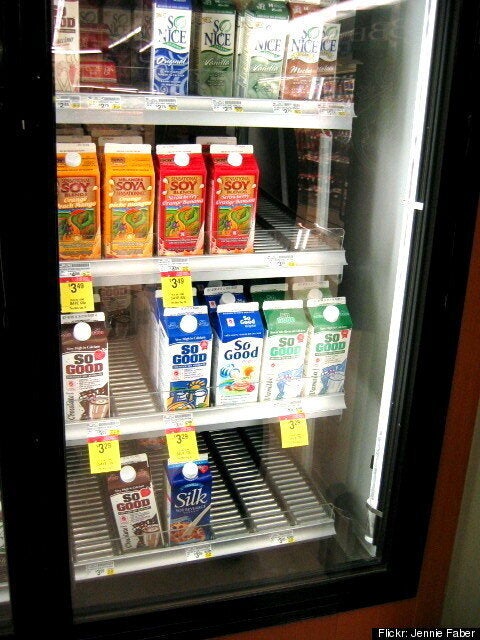
The debate over the potential benefits and dangers of eating soy is ongoing and often heated. Is soy good for you or should you avoid it? If you do eat soy, how much is OK to eat? There is research to support both sides of the issue. One way to approach the debate is to think of soy like chocolate.
In addition to being a good source of folic acid, copper and magnesium, chocolate and cocoa contain flavanols, a type of flavonoid that has antioxidant properties and a positive impact on blood pressure and improved blood flow to the heart and brain.(1) However, because flavanols are lost during manufacturing, you get the most flavanols from minimally processed chocolate and cocoa, which typically includes dark chocolate rather than milk chocolate and cocoa powder without Dutch processing.(2)
But chocolate, especially milk chocolate, has downsides: It is high in saturated fat and calories, and cocoa butter can raise cholesterol. Chocolate also is a source of oxalates, which can increase the risk of kidney stones for certain people.(3) So when consumed in moderation, the healthiest types of chocolate may offer some health benefits, but wolfing down a few milk chocolate bars every day does not.
Similarly, there are benefits and risks associated with consuming soy and soy foods. If we focus on men's health, there are questions about the impact of this low-fat, cholesterol-free protein source on prostate health. One controversy involves whether soy isoflavones, plant-derived compounds that have very mild estrogen-like (phytoestrogen) activity, can cause, stimulate, or otherwise promote hormone-driven cancers such as prostate and breast cancer.
In the October 2010 issue of Clinical and Experimental Metastasis, researchers reported on the effects of soy isoflavones (genistein, daidzein, and combined soy isoflavones) in established cancers in mice. Genistein decreased mammary tumor growth by 33 percent while daidzein increased it by 38 percent when compared with placebo. Daidzein increased heart and lung metastases while genistein decreased bone and liver metastases. Combined isoflavones did not affect primary tumor growth but they did increase metastasis to the lung, liver, heart, kidney and bones. The authors concluded that consumption of soy foods may increase metastasis. (4)
On the flip side, a recent U.S. Department of Agriculture meta-analysis of "up-to-date available epidemiologic studies" found that "consumption of soy foods is associated with a reduction in prostate cancer risk in men." (5) Specifically, a 26 percent reduction was seen when comparing the highest intake of soy foods with the lowest. The reduced risk rose to 30 percent when the researchers separated out nonfermented and fermented soy foods (e.g., natto, miso, tempeh), and found that tofu and soy milk were associated with the higher reduction in risk, but "intake of fermented soy foods was not associated with the risk." Despite an apparent lack of studies comparing the effects of fermented vs. nonfermented soy foods on tumor development in lab animals, studies of miso show that it inhibits breast, stomach and colon carcinogenesis. (6)
Several other studies support the benefits of soy for prostate health, including two in which genistein slowed the growth of prostate tissues in benign prostatic hyperplasia (BPH or basically, an enlarged prostate) and interfered with the growth of prostate cancer cells. (7) Large population studies also show that when people consume more genistein-rich foods, prostate cancer rates are lower than when genistein consumption is less. (8)
The downsides of soy are important to note, although these disadvantages do not apply to fermented soy foods, as fermentation seems to destroy the toxins in soybeans.
•Soybeans contain high amounts of phytic acid, a type of phytate and a substance that blocks the body's absorption of calcium, magnesium, copper, iron and zinc. Fermentation significantly reduces phytate content.
•Soybeans contain inhibitors that block the action of trypsin and other enzymes needed to digest protein. These enzyme inhibitors are not completely deactivated during ordinary cooking, but they are when soybeans are fermented.
•Haemagglutinin, a clot-promoting substance, is present in soybeans, but it is deactivated during fermentation.
•Soy promotes the formation of an enlarged thyroid, or goiter. The responsible elements appear to be genistein and equol, a metabolite of daidzen. Isoflavones also inhibit thyroid peroxidase, which produces the thyroid hormones T3 and T4. Kaayla Daniels, Ph.D., author of "The Whole Soy Story," suggests that soy's negative impact on the thyroid occurs mostly when isoflavone intake is more than 30 mg daily. (9)
So as with chocolate: a little can be helpful, but too much can contribute to health problems. How much soy is healthy? A detailed review in Nutrition and Cancer reported that soy protein consumption in Japan, where prostate and breast cancer rates are very low, averages between 6 and 11 grams daily, and isoflavone consumption averages between 25 and 50 mg daily. (10) In the United States, some people eat as much as 80 to 100 mg of isoflavones per day in soy milk, soy protein shakes, and protein bars. Here's a general idea of how this breaks down.
First you should know that isoflavone content in soybeans can vary from crop to crop, so we are dealing with averages. One hundred grams of firm tofu (about 3.3 ounces) contains about 15.78 grams of soy protein and 28 mg of isoflavones. Some soy protein bars say they guarantee their isoflavone content to be 3.4 mg per gram of protein, so a bar that contains 14 grams of soy protein would provide 47.6 mg isoflavones. Eating two such protein bars a day would place you near the 100 mg mark. You can see the soy protein and isoflavone content of other soy foods in the "Pennsylvania State University" article "Soy Protein and Soy Isoflavones."
Another issue regarding American soy consumption is attitude. "Soy" has become a buzz word in the food industry, where it is becoming more of a brand than a food. Manufacturers promote soy protein bars, kids' cereals with added soy, and soy protein mixes targeted for athletes as being "healthy." But just because a product contains soy does not automatically mean it is good for you as the soy branding is often a smokescreen for an otherwise unhealthy product containing sugars, additives, artificial flavors and other ingredients of questionable health.
Not all soy products are created equal. Like 99 cent tacos, you get what you pay for. Manufacturers make it cheap, throw on a brand like "soy" and sell it as hard as they can. It doesn't matter whether it is good for you or not. To me, soy is like the professional athlete that signs an unlimited use licensing agreement for his/her name and suddenly finds their image on the side of a cigarette box. Consumers need to read nutritional and ingredient labels and not be swayed by marketing buzz words that grab your attention in the supermarket and have been taken over by the industrial food companies.
Also be aware of the type of soy in foods. When you read ingredient labels look for "soy protein isolate" and "textured soy vegetable protein," which are produced using high temperatures. The by-products of this process are potential cancer-causing substances called nitrosamines and toxic lysinoalanine. Therefore, foods and supplements like soy protein bars and soy protein powders that contain soy protein isolates should be avoided. Highly processed soy products may also contain aluminum, which is toxic to the kidneys, nervous system and brain. (11)
One more critical issue is genetically modified (GM) soy. More than 90 percent of the soybeans raised in the United States are genetically modified. Of these, chemical giant Monsanto's Roundup Ready soybeans made up 92 percent of the U.S. soybean crops in 2008. Along with the fact that no one has definitively determined that GM soybeans (or other GM crops) are safe, soybeans require more pesticides than conventional soybeans, exposing consumers to yet more toxins. (12) And even forgetting the safety of GMO foods for a moment, the fact that a company has named a product on the basis of its resistance to a pesticide should be the biggest red flag to consumers. Monsanto is obviously not a marketing genius when it comes to branding.
You get the point. Be a savvy shopper and read labels more carefully. Make sure the soy foods you enjoy are not genetically modified and do not contain soy protein isolates and other undesirable ingredients, such as fructose, corn syrup and artificial sweeteners and flavors. Check the amount of calories and fat, especially saturated fat, per serving. Soy, like chocolate, can be enjoyed in moderate amounts in certain forms but don't be taken in by the marketing pitches and misleading labels. In the case of soy, like chocolate, you can have too much of a good thing.
See also:
References:
1.Cleveland Clinic, "The Sweet Truth About Chocolate and Your Heart"
2.Cleveland Clinic, "The Sweet Truth About Chocolate and Your Heart"
3.National Institute of Diabetes and Digestive and Kidney Disease
4.Martinez-Montemayor MM et al. Individual and combined soy isoflavones exert differential effects on metastatic cancer progression. Clin Exp Metastasis 2010 Oct; 27(7): 465-80
5.Yan L, Spitznagel EL. Soy consumption and prostate cancer risk in men: a revisit of a meta-analysis. Am J Clin Nutr 2009 Apr; 89(4): 1155-63.
6.Gotoh T et al. Chemoprevention of N-nitroso-N-methylurea-induced rat mammary carcinogenesis by soy foods or biochanin A. Jpn J Cancer Res 1998; 89:137-42; Watanabe H et al. Influence of concomitant miso or NaCl treatment on induction of gastric tumors by N-methyl[n-nitro-N-nitrosoguanidine in rats. Oncol Rep 1999; 6:989-93; Ohuchi Y et al. Decrease in size of azoxymethane induced colon carcinoma in F344 rats by 180-day fermented miso. Oncol Rep 2005; 14:1559-64.
7.Raffoul JJ et al. Genistein inhibits radiation-induced activation of NF-kappaB in prostate cancer cells promoting apoptosis and G2/M cell cycle arrest. BMC Cancer 2006 Apr 26; 6:107; Kazi A et al. Inhibition of the proteasome activity, a novel mechanism associated with the tumor cell apoptosis-inducing ability of genistein. Biochem Pharmacol 2003 Sep 15; 66(6): 965-76.
8.Moline B, Georgel P. Genetic and epigenetic regulation of prostate cancer by genistein. Drug News Perspect 2009; 22(5): 247-54.
9.Daniels K. "The Whole Soy Story." Washington DC: New Trends Publishing, 2005.
10.Messina M et al. Estimated Asian adult soy protein and isoflavone intakes. Nutrition and Cancer 2006; 55:1-12.
11.Melead, Leia, NP.
12.The Organic & Non-GMO Report. More US farmers planting non-GMO soybeans this year.
